How To Make Wheat Starch
Liangpi, which translates to "cold peel" noodles, is a street food dish originally from Shaanxi Province. It has go popular throughout China and even away for adept reason. Liangpi dishes are delicious, specially during the summertime.
Liangpi's springy, elastic, and virtually glace texture makes it an platonic candidate for cold noodle dishes, slathered in flavorful sauces with refreshing crunchy vegetables like cucumber and edible bean sprouts. I recently shared a spicy liangpi recipe, and today, I'm going to show yous how to make the noodles!
That's right, you're gonna learn how to brand your own fresh liangpi using just flour, water, and salt. Information technology'south a scrap of a process, but if y'all're craving these noodles or would like to effort them for the outset fourth dimension, it'southward a cool bit of "project cooking" with a delicious advantage at the end!
What Are Liangpi Noodles?
Liangpi noodles can be made with either wheat or rice. Indeed, the texture of liangpi is similar to fresh rice noodles, like those in my mom'due south bootleg rice noodle recipe . The method of cooking (steaming a sparse starch-based batter) is also very similar.
However, liangpi is most traditionally made with wheat flour. That's right––the regular ol' all purpose flour y'all probably employ in most of your baking.
How To Make Liangpi
The process involves making a simple flour/h2o dough (with a bit of salt added), and repeatedly "washing" it to separate the starch from the gluten in the flour. This "washing" process may seem a bit strange. When else would you always make a dough and then showtime bashing it in a basin of h2o?
But one time the starch is separated from the gluten, you tin utilize it to brand a noodle batter! That batter is then steamed in thin sheets, which tin can then be sliced into noodles.
The remaining wheat gluten by-production is edible too. In fact, you may know information technology by its more common name––seitan! That's right, you get two products for the price of ane. Not just exercise you get a big pile of chewy noodles, yous also become a sizable piece of seitan.
In Chinese, this production is known as kaofu, which is featured in my mom'south Braised Kao Fu (Wheat Gluten) with Mushrooms recipe .
This is why liangpi dishes are often tossed with pieces of wheat gluten. They're fabricated in the same procedure! The spongy texture of the kaofu makes it PERFECT for soaking up tasty sauce.
At that place are many shortcuts out in that location for making liangpi. Some methods utilise simply pure wheat starch and h2o. Some use a simple "unwashed" flour and water mixture. However, those recipes are non traditional, and yous won't get the gluten by-product out of it.
While we may publish a shortcut version in the futurity, we accept to start with the OG! This recipe will show yous how to make liangpi in the way information technology was originally intended.
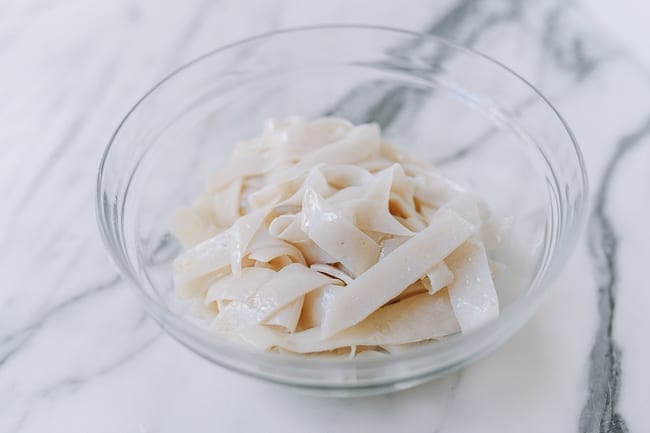
It does take some work, merely if y'all can't find prepared liangpi at your local Chinese market, or merely desire a bit of a fun scientific discipline projection to do on a weekend (this is great to exercise with kids), give this recipe a effort. Afterward all, nosotros all need more stuff to practice and experiment with at dwelling house these days!
Mixer Method vs. By Mitt
I used my stand up mixer for almost the entire dough making/washing process, and information technology was a snap. The dough hook did all the kneading and "washing" for me, and all I had to practice was set a timer and keep track of each washing step.
While the mixer was going, I could putter around the kitchen doing other things, read, scout Telly, whatever!
If you don't take a stand mixer, the procedure is admittedly a bit labor intensive. It will take almost 45 minutes of active prep. All the same, if doing it past hand, y'all'll be making liangpi the same way Chinese cooks have been doing information technology for generations.
Concluding Notes
- You should either start this recipe the night before you plan to eat these noodles (if you want them for tiffin), or early in the morning time on the twenty-four hours of (if you lot want them for dinner). The prep process of making the dough and "washing" information technology takes about 90 minutes (45 minutes of which is "active prep"). Even so, the starchy h2o needs at least 6 hours to fully settle, and so you tin easily cascade off the h2o and have just starch remaining.
- While I included US cup/teaspoon measurements in this recipe, use a digital kitchen calibration for best results. If you lot don't already own one, they're relatively cheap ($11-18). It really is a key tool that we use in our kitchen most every twenty-four hour period!
- If yous're wondering how to serve your liangpi noodles after they're done, bank check out our Spicy Cold Skin Noodles recipe , which shows y'all how to get together the dish with sauce and vegetables. In that location are numerous ways to ready/dress liangpi noodles, but our method is pretty traditional, and also very tasty!
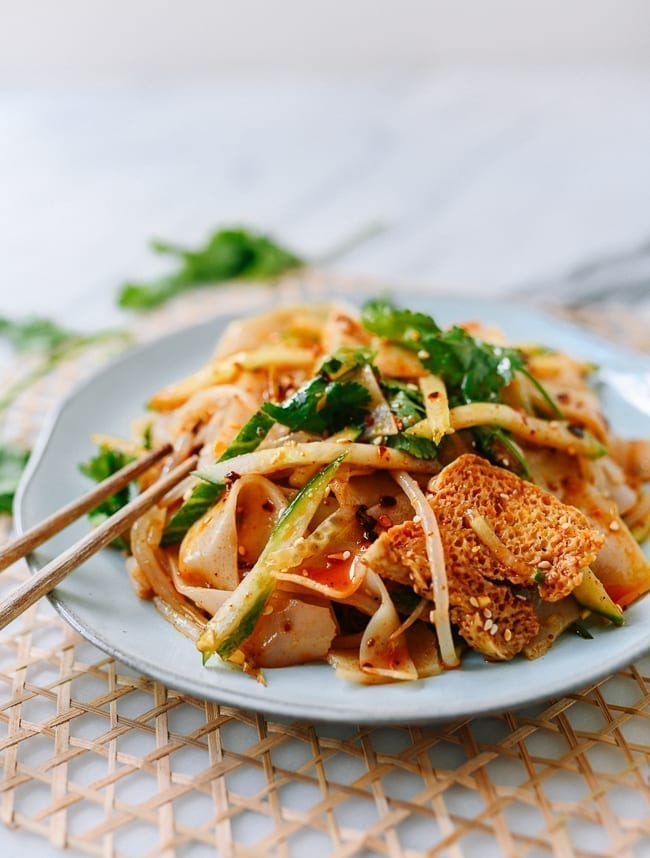
Ok, on to the recipe!
Liangpi Recipe Instructions
Phase ane: Dissever the Starch & Gluten
Combine 450g flour and 4g common salt in a big mixing bowl, or the bowl of a stand mixer fitted with the dough claw attachment.
Every bit I mentioned in the introduction, information technology's all-time to measure the flour by weight using a kitchen scale.
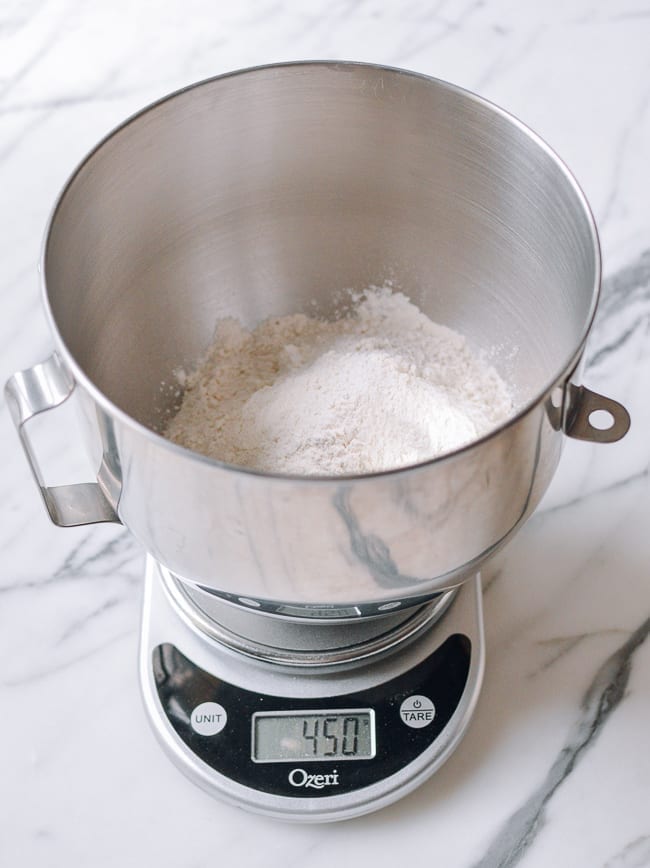
If kneading by hand, combine the dry mixture with 250g water gradually by manus until a shaggy dough forms. If using a mixer, turn the mixer on low speed (usually the "stir" setting), while gradually pouring in the water until you have a shaggy dough.
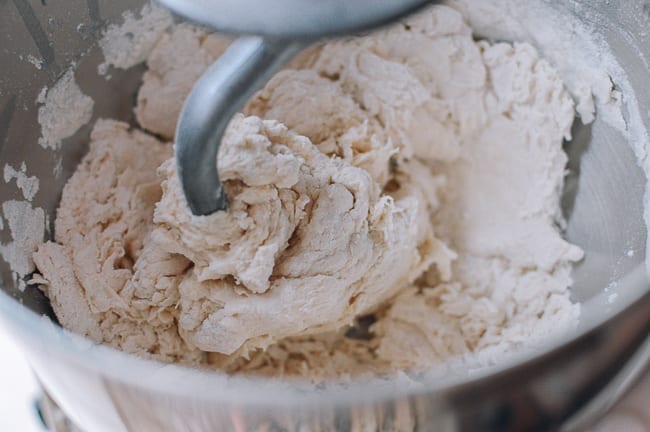
One time you've formed dough, knead it for well-nigh 3 minutes, or until information technology forms a relatively house, cohesive ball. Cover and rest for ten minutes.
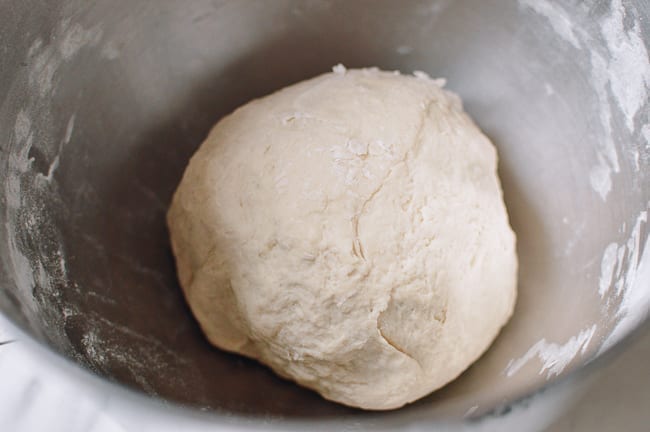
Knead the dough over again by manus for about 1 infinitesimal until it forms a smooth brawl. Cover and rest for 30 minutes.
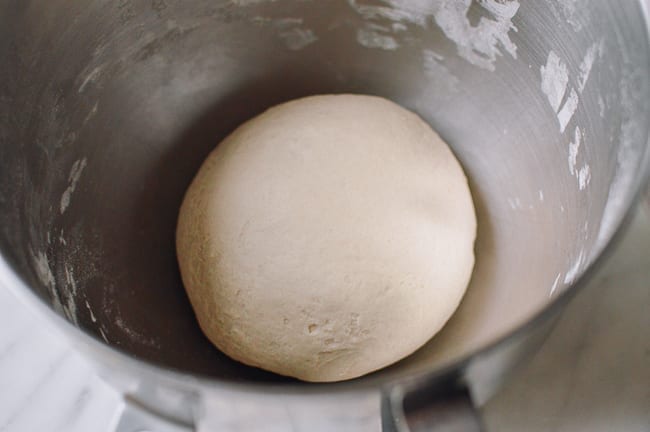
To the dough in the basin, add together 3 cups of water. Push the dough downward into the water to fully submerge it, and soak it for 5 minutes.
Adjacent, begin the "washing" procedure. Traditionally, this is done past manus. While the dough is still submerged in the water, squeeze and stretch it between your fingers to release the starch. Wash until the dough loses its shape and the water is opaque white, about 2-3 minutes.
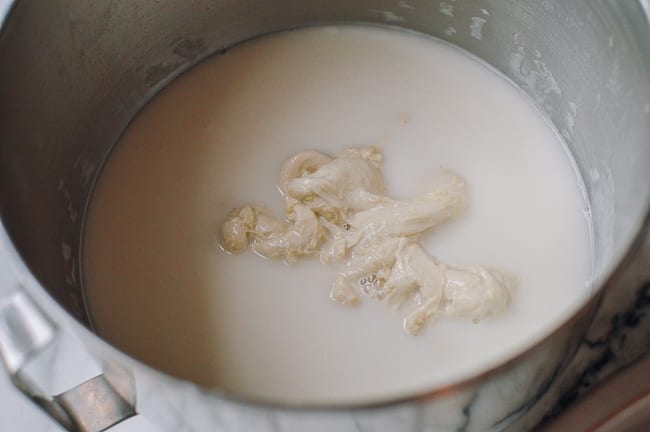
Alternatively, you can use a mixer to do this work for yous. Place the mixing bowl of dough/h2o dorsum on the mixer with the dough hook attachment. Place the pouring shield/splash guard on the mixer and turn it on at the lowest setting. Permit the dough claw massage the dough for ii minutes.
(At that place is some risk of splashing with this first step since this is the most water y'all will apply at i time, and then you may cull to practice this start pace past mitt.)
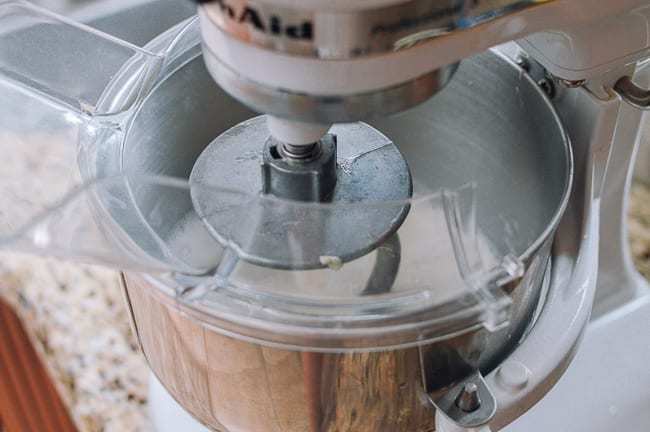
Pour out the starchy water into another large basin and gear up bated (this is the bowl of starch y'all volition be using to make the noodles).
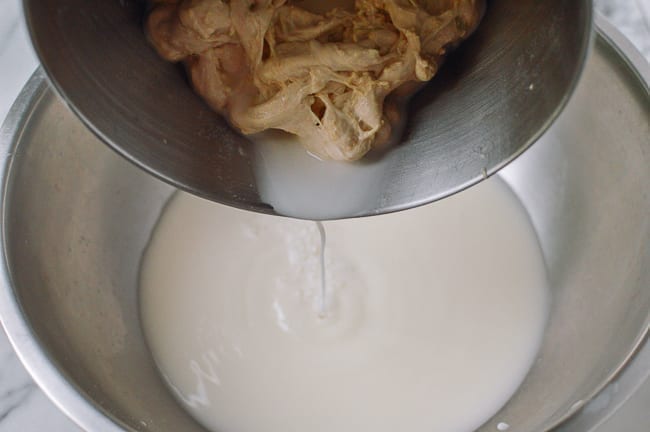
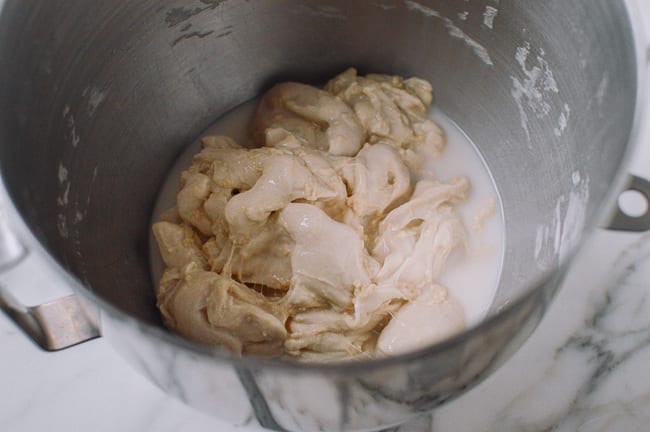
Add two more cups of fresh h2o to your dough and launder over again for iii minutes. This time, strain off the starchy h2o with a fine meshed strainer (as the dough becomes more cleaved up, little pieces will begin to separate out).
Repeat one more time with 2 cups of fresh water, for a total of 3 "washings" so far.
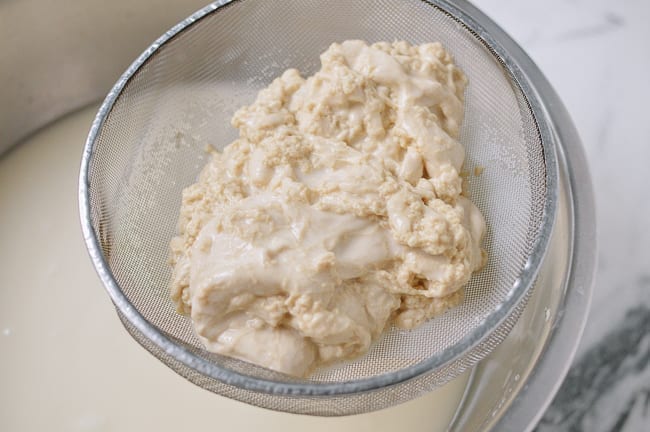
After y'all've strained off your third batch of starchy h2o, add 1 cup of fresh h2o to the dough, and massage for 4 minutes. (Y'all'll accept to massage it longer to remove the remaining starch. If you're using a mixer, you can also plough the speed up i notch, at present that in that location'south less risk of splashing.) Do this step (with 1 cup fresh water) 3 times, for a full of 6 "washings" thus far. If using a mixer, clasp the dough between your fingers a few times after each washing to thoroughly release as much starch as possible.
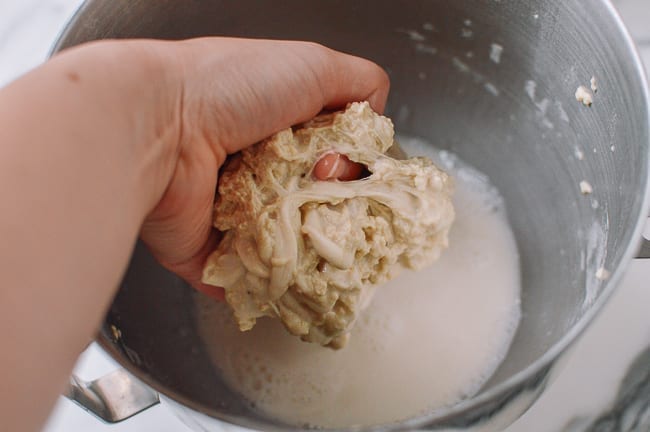
Next, add together a cup of water and wash again for a few minutes by hand to really squeeze out the final remaining bits of starch.
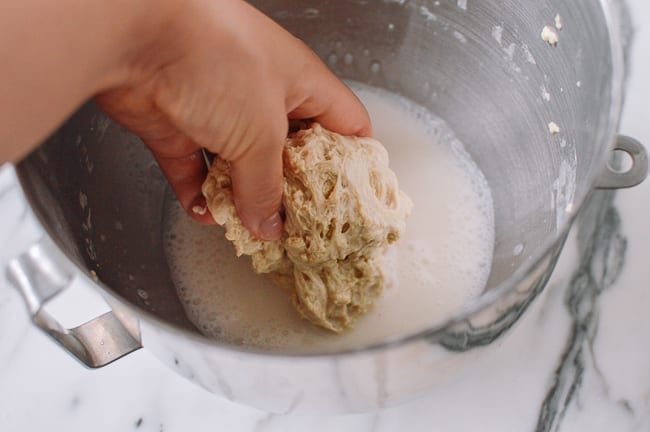
Exercise this 1-ii more times, until the water is mostly clear and your gluten ball comes together. If the h2o is mostly clear, you can discard information technology rather than adding it to your basin of starchy liquid.
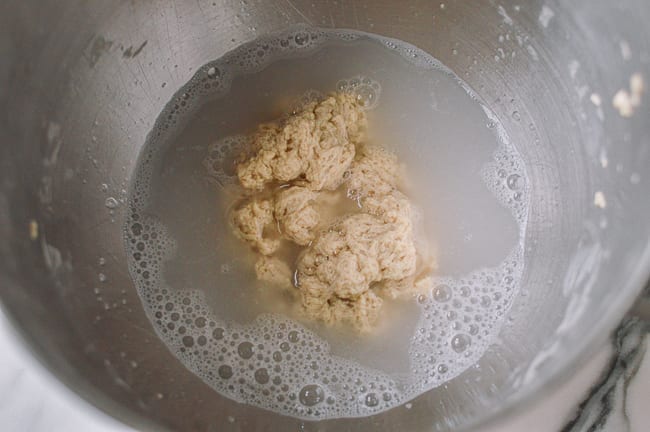
Phase 2: Strain & Permit Starch to Settle
Prepare the gluten ball aside, covered with an overturned basin, to let the gluten to relax at least two hours (you can store information technology in the refrigerator longer as well). Just make certain it remains covered, or it will dry out.
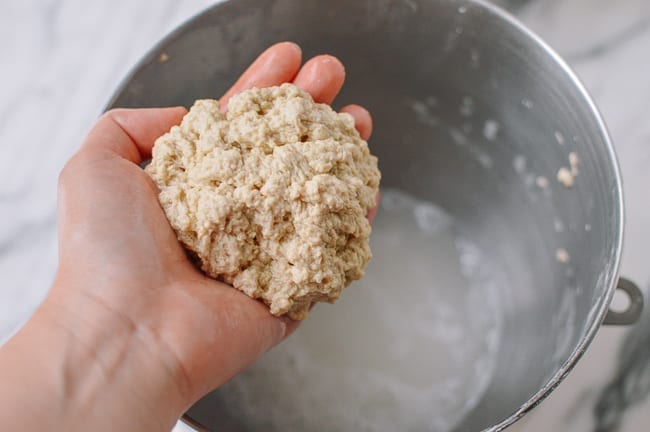
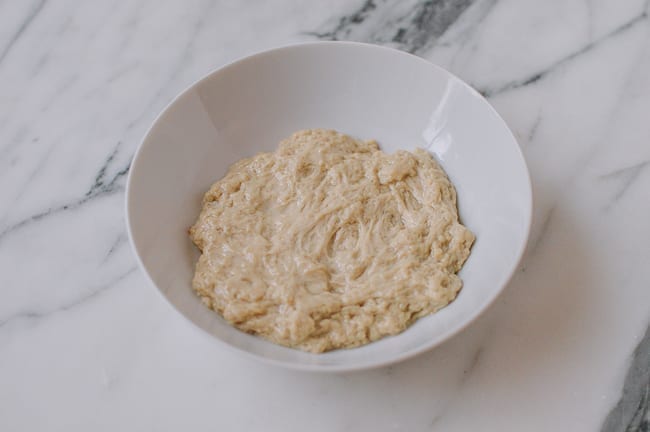
Strain the starchy water through a fine meshed strainer into some other large bowl, to remove whatever dough solids that may have slipped by.
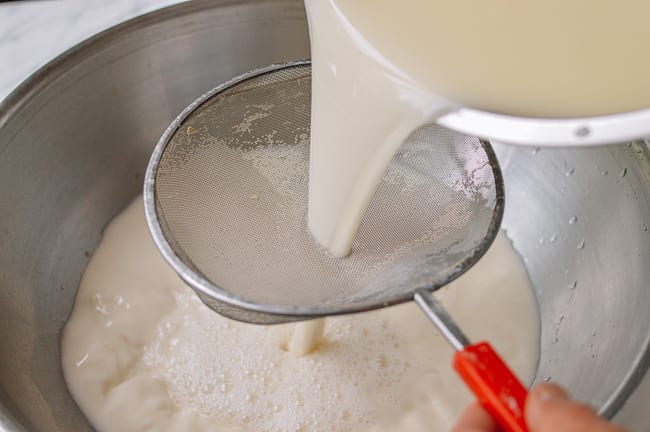
Ready aside for at to the lowest degree six hours or overnight. You can set it out at room temperature if it'south not too hot/humid, or in the refrigerator. This allows the starch in the water to settle fully to the lesser of the bowl. You can't shortcut this step––believe me, I tried! Information technology'll wait like the starch is settling speedily, just y'all actually need the full 6 hours for all the suspended starch to fully settle and meld to itself at the bottom of the bowl.
Stage 3: Cook Noodles & Wheat Gluten
Uncover your reserved wheat gluten, and steam information technology for thirty minutes. Prepare aside.
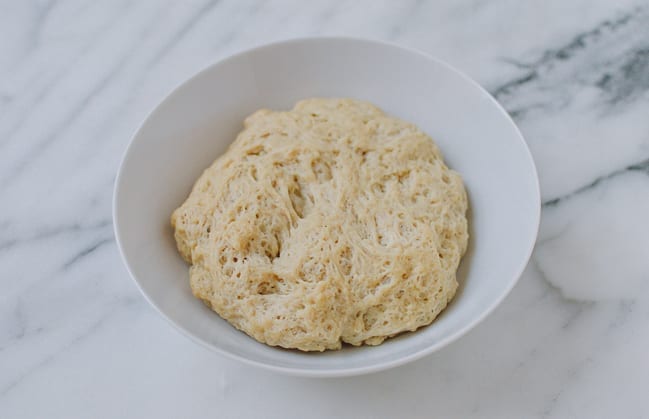
While the gluten is steaming, pour off the water from the starchy liquid bowl, leaving just the thick glue-like layer of white starch at the lesser.
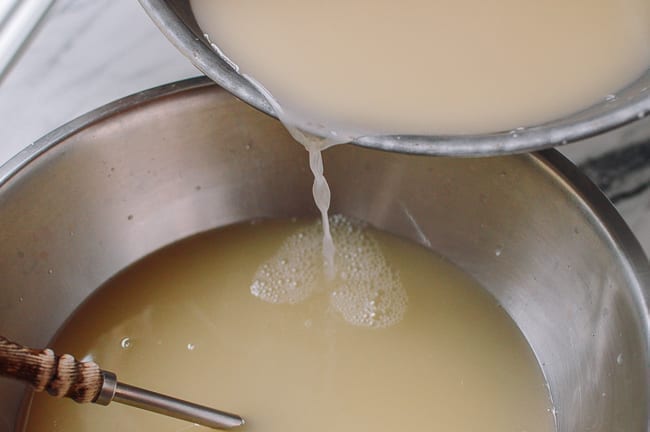
When y'all've poured off all the water, use a metal spoon or ladle to scrape the starch from the bottom of the basin. Stir the thick liquid so the mixture is completely homogeneous throughout. There should be no lumps of starch remaining. Using your ladle and a kitchen scale, ladle out 300g of the starchy mixture into a split medium bowl.
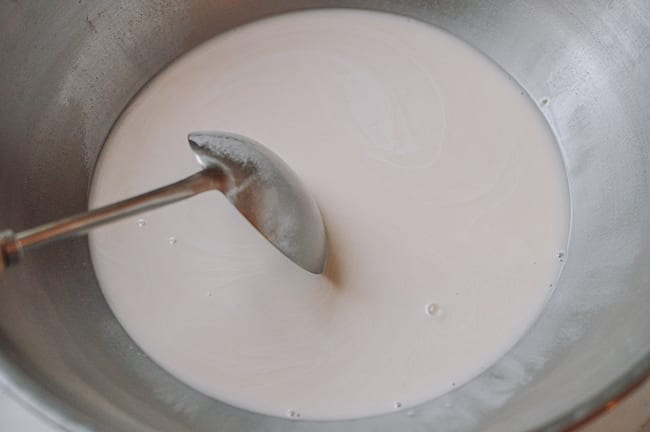
To that, add 2g (½ teaspoon) table salt and 150ml (most ⅔ cup) fresh water. Mix until well combined. This is your noodle concoction.
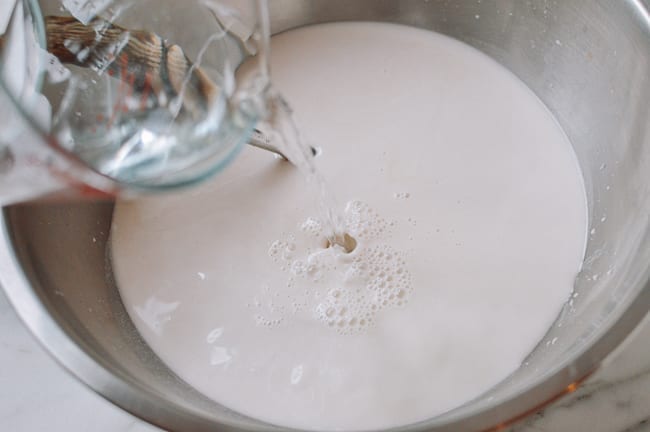
Bring water to a boil in your steamer. Castor vegetable oil on a circular or square cake pan. Remember that information technology must be able to fit in your steamer. A lite metal cake pan works best.
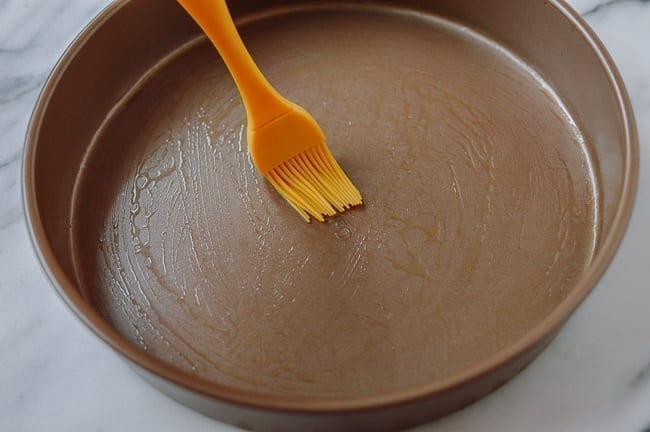
Pour a thin layer of batter into the oiled pan, so that information technology just covers the entire bottom of the pan.
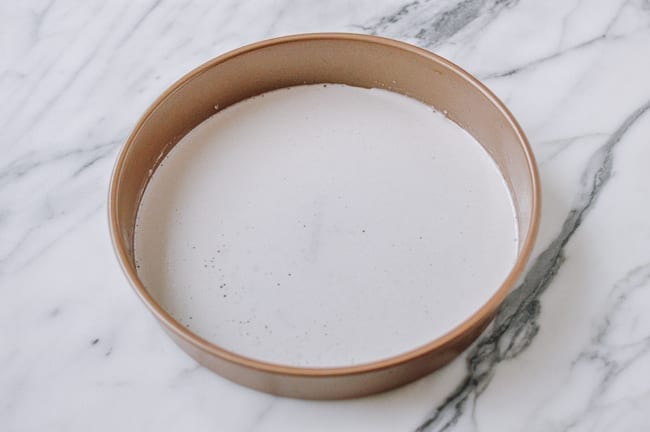
Immediately put in the steamer, cover, and steam for xc seconds to 2 minutes. Alternatively, you tin steam the noodles direct on elevation of simmering h2o in a wok with a lid, similar my mom did in her homemade rice noodle recipe.
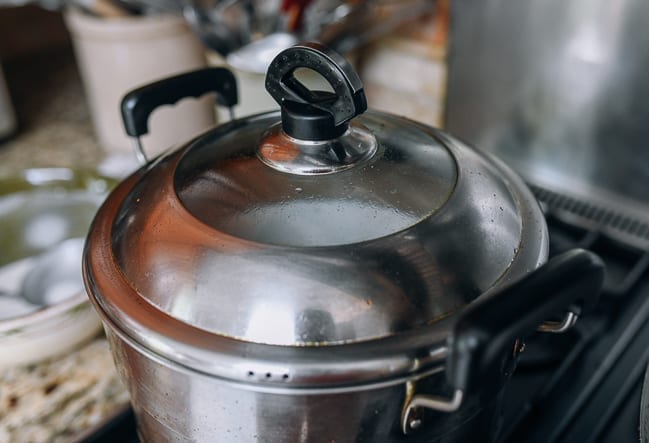
Meanwhile, prepare a large basin of cold water––you can put a few water ice cubes in it to make certain it stays cold. Advisedly remove the pan from the steamer and gear up it on the surface of the cold h2o so it tin cool.
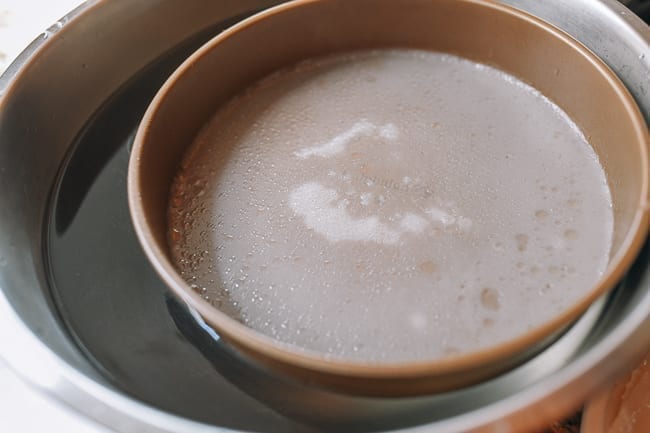
When the noodle is cool to the touch (it will take near 1 minute to absurd), brush the surface with a thin layer of oil, and carefully skin it off the oiled pan using a condom spatula and your easily.
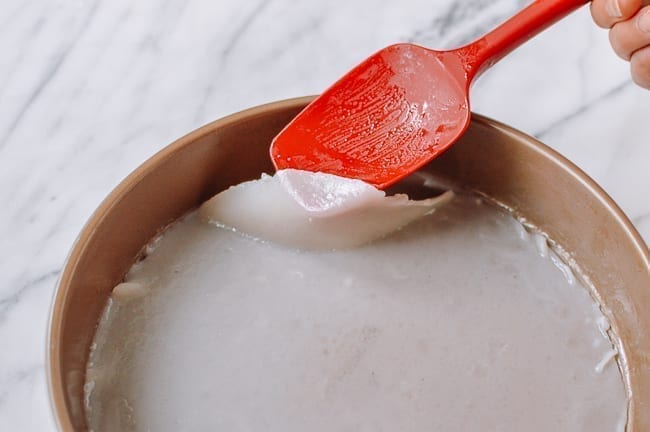
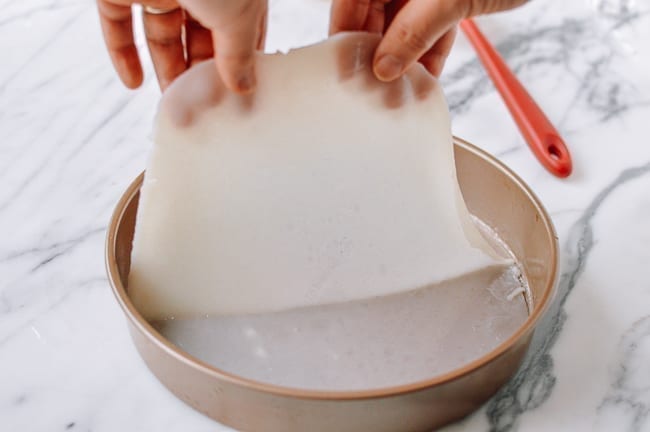
Echo this process, thoroughly stirring the batter earlier you ladle it into the pan every single fourth dimension (the starch rapidly settles, so you lot have to brand sure the mixture is evenly combined each time to go the correct ratio of starch to water). Be sure to scrape upwards whatever starch that has settled to the lesser, and comprise it back into the batter. Equally you brand your noodles, oil them thoroughly and stack on top of one some other.
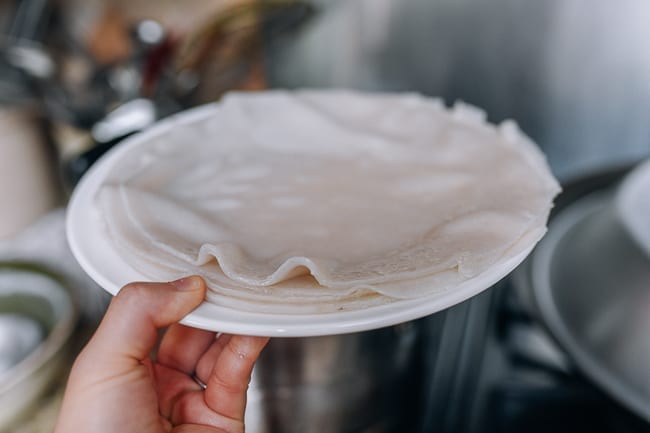
When you run out of batter, mensurate out another 300g of the starch. Add 150 ml water to make more batter. Y'all will have about three full batches. If the remaining total starch does not exactly measure 900g, just know that y'all need nearly ½ the weight of water to starch. Basically, split whatever your starch weight is in one-half, and that is the weight/volume of water you need (when measuring water, 1g = one ml).
When finished, slice the noodles and separate them.
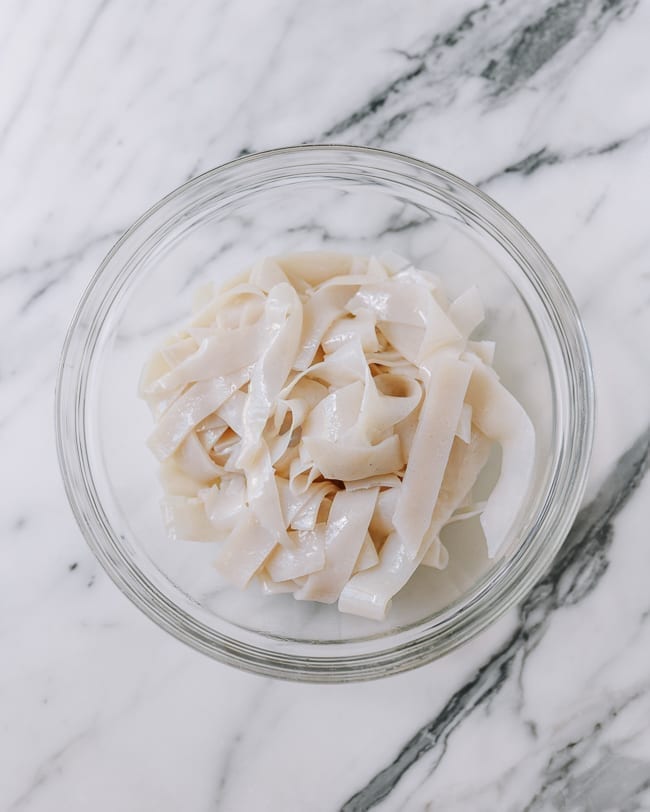
Also piece the steamed gluten.
This recipe makes enough for about 6 servings of liangpi noodles. If y'all have leftover noodles, transfer them to an airtight container, and air-condition. They will keep for ii-iii days. Just brand sure they're tightly covered, or they can dry out!
To run across how we like to serve our liangpi, check out our Spicy Cold Skin Noodles recipe .
Prep: 1 hour 30 minutes
Cook: 1 hr
Full: 8 hours 30 minutes
- 450 yard all purpose flour (450g = about iii ¼ cups; measure by weight for best results)
- 4 g salt (4g salt = 1 teaspoon)
- 250 grand h2o (250g h2o = 250 ml = about 1 cup; will need more for washing/concoction)
PHASE i: Dissever the Starch & Gluten
-
Combine 450g flour and 4g common salt in a large mixing bowl, or the bowl of a stand mixer fitted with the dough claw attachment. If kneading by paw, combine the dry mixture with 250g water gradually by mitt until a shaggy dough forms. If using a mixer, plow the mixer on low speed (ordinarily the "stir" setting), while gradually pouring in the water until y'all have a shaggy dough.
-
One time you've formed dough, knead it for nearly iii minutes, or until it forms a relatively business firm, cohesive ball. Cover and rest for 10 minutes. Knead the dough again past hand for about 1 minute until it forms a smooth ball. Embrace and residual for 30 minutes.
-
To the dough in the bowl, add iii cups of water. Push the dough downward into the water so it's fully submerged, and soak it for 5 minutes.
-
Next, begin the "washing" process. Traditionally, this is done past hand. While the dough is still submerged in the water, squeeze and stretch it betwixt your fingers to release the starch. Wash until the dough loses its shape and the h2o is opaque white, about 2-3 minutes. Alternatively, you lot can use a mixer to do this work for you. Place the mixing bowl of dough/water dorsum on the mixer with the dough hook attachment. Place the pouring shield/splash guard on the mixer and plow information technology on at the lowest setting. Let the dough claw massage the dough for two minutes. (There is some risk of splashing with this commencement step since this is the most water y'all will use at one fourth dimension, so you may choose to do this showtime step by hand.)
-
Pour out the starchy h2o into another big bowl and set up aside (this is the bowl of starch you will exist using to make the noodles). Add 2 more cups of fresh h2o to your dough and launder again for 3 minutes. This time, strain the starchy water with a fine meshed strainer (equally the dough becomes more cleaved upwards, little pieces will begin to separate out). Repeat one more time with 2 cups of fresh water, for a total of iii "washings" so far.
-
Later you've strained your third batch of starchy water add together 1 cup of fresh water to the dough, and massage for 4 minutes. (You'll have to massage it longer to remove the remaining starch. If you're using a mixer, you tin also plough the speed up one notch, now that at that place's less adventure of splashing.) Practice this pace (with 1 cup fresh water) 3 times, for a total of half-dozen "washings" thus far. If using a mixer, clasp the dough betwixt your fingers a few times after each washing to thoroughly release as much starch as possible.
-
Next, add a loving cup of water and wash again for a few minutes past hand to actually clasp out the last remaining bits of starch. Do this 1-2 more times, until the water is mostly articulate and your gluten ball comes together. If the h2o is mostly articulate, you can discard information technology rather than adding it to your bowl of starchy liquid.
Stage ii: Strain & Allow Starch to Settle
-
Set the gluten ball aside, covered with an overturned bowl, to allow the gluten to relax at least ii hours (you can store it in the refrigerator). Keep it covered, or information technology will dry out. Strain the starchy water through a fine meshed strainer into another large bowl, to remove whatever dough solids that may accept slipped by.
-
Fix aside for at least 6 hours or overnight (at room temperature if it's non likewise hot/humid, or in the refrigerator). This allows the starch in the water to settle fully to the bottom of the bowl. You can't shortcut this step––believe me, I tried! Information technology'll look like the starch is settling rapidly, but yous really need the full 6 hours for all the suspended starch to fully settle and meld to itself at the bottom of the basin.
Phase iii: Cook Noodles & Wheat Gluten
-
Steam your gluten for xxx minutes and set up bated. While the gluten is steaming, pour off the water from the starchy liquid bowl, leaving only the thick glue-like layer of white starch at the bottom. When all the water is poured off, employ a metal spoon or ladle to scrape the starch from the bottom of the bowl, and stir the thick liquid and then the mixture is completely homogeneous throughout (there should be no lumps of starch remaining). Using your ladle and a kitchen scale, ladle out 300g of the starchy mixture into a separate medium bowl.
-
To that, add 2g (½ teaspoon) salt and 150ml (almost ⅔ cup) fresh water. Mix until well combined. This is your noodle batter.
-
Bring water to a boil in your steamer. Brush vegetable oil on a round or square cake pan (it must be able to fit in your steamer). Pour a thin layer of batter into the oiled pan, so that it simply covers the entire bottom of the pan. Immediately put in the steamer, embrace, and steam for ninety seconds to 2 minutes. Alternatively, you tin can steam the noodles directly on top of simmering water in a wok with a hat, like my mom did in her bootleg rice noodle recipe.
-
Meanwhile, prepare a big bowl of cold water––you can put a few water ice cubes in information technology to make sure it stays cold. Carefully remove the pan from the steamer and set it on the surface of the cold water and then it can absurd. When the noodle is cool to the touch (it volition take about 1 minute to cool), brush the surface with a thin layer of oil, and carefully peel it off the oiled pan using a rubber spatula and your easily.
-
Repeat this process, thoroughly stirring the concoction earlier you ladle it into the pan every single time (the starch apace settles, so you accept to make sure the mixture is evenly combined each time to become the right ratio of starch to water). Be sure to scrape upwards any starch that has settled to the lesser, and incorporate it back into the concoction. Equally you make your noodles, oil them thoroughly and stack on top of one another.
-
When you run out of concoction, measure out another 300g of the starch, and add 150 ml h2o to make more. You will have nigh three total batches. If the remaining full starch does not exactly measure out 900g, simply know that you need nearly ½ the weight of h2o to starch. Basically, split up any your starch weight is in half, and that is the weight/volume of water you demand (when measuring h2o, 1g = 1 ml).
-
When your noodles are done and cooled, slice them, and slice the gluten. To see how we like to serve our liangpi, bank check out our Spicy Cold Pare Noodles recipe.
If you lot take leftover noodles, transfer them to an airtight container, and refrigerate. They will keep for 2-iii days. Just make certain they're tightly covered, or they can dry out!
Calories: 273 kcal (14%) Carbohydrates: 57 grand (19%) Protein: 8 g (16%) Fatty: 1 thou (2%) Saturated Fatty: one g (5%) Sodium: 262 mg (eleven%) Potassium: 80 mg (2%) Fiber: two g (8%) Carbohydrate: one g (1%) Calcium: 11 mg (one%) Iron: 3 mg (17%)
Source: https://thewoksoflife.com/liangpi-noodles/
Posted by: blackalver1982.blogspot.com


0 Response to "How To Make Wheat Starch"
Post a Comment